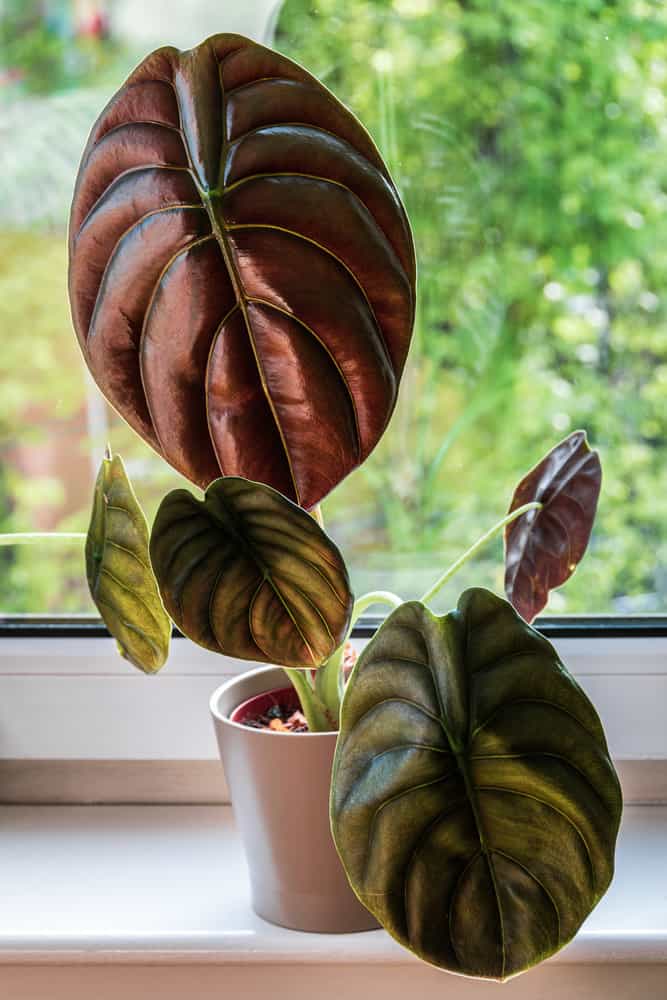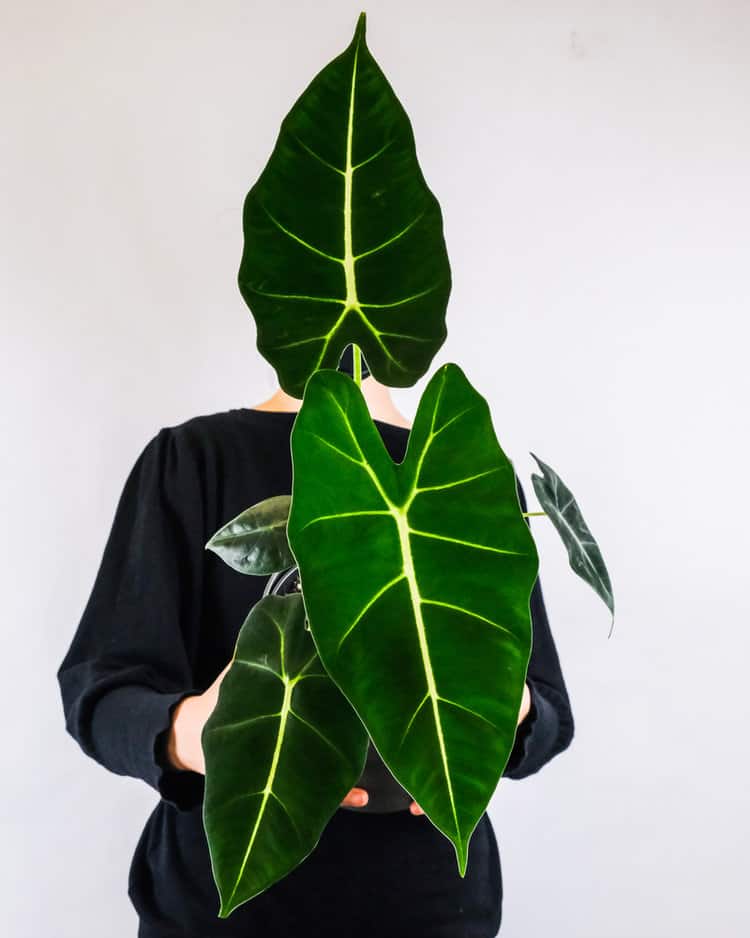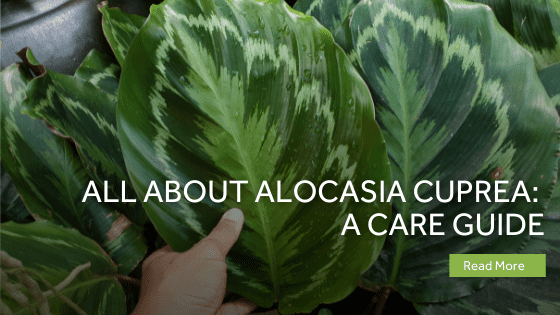Alocasia cuprea, commonly known as the Jewel Alocasia, is a species of flowering plant in the arum family. It is native to Southeast Asia, where it grows in tropical rainforests. The plant has large, glossy leaves that are copper-colored on the undersides and green on the topsides. In this article, you will learn everything there is to know about Alocasia cuprea.
Table of Contents
Alocasia cuprea Overview
The Alocasia cuprea is a stunning plant that makes any space shine. This species is tropical in origin and part of the Alocasia genus, home to many other extraordinary plants. Also commonly known as the “Mirror plant” or “Jewel Alocasia,” the Alocasia cuprea thrives in medium to bright direct light due to its tropical nature. This light, combined with proper watering and humidity, will produce a magnificent plant with glossy and large leaves to brighten your space.
While the Alocasia cuprea is found natively in the warm, humid climates of South America and Asia, this species can thrive in your home environment with the proper care.
This species has coined the nicknames Jewel alocasia and Mirror plant due to its shiny and impressive foliage. A full-grown Alocasia cuprea’s leaves can grow up to 3 feet and sports a beautiful ruby coloring. Other popular varieties related to the Alocasia cuprea include the magnificent Alocasia amazonica and Alocasia microrrhizos.
Alocasia amazonica: also known as the “elephant ear,” this variety has dark green and bronze leaves with striking white veins.
Alocasia microrrhizos, commonly named “giant taro,” also has the characteristic large leaves and has been cultivated in its native areas for edible rhizomes.
| Botanical Name | Alocasia cuprea |
| Family | Araceae |
| Genus | Alocasia |
| Origin | Asia and South America |
| Sunlight | Medium / bright indirect light |
| Watering | Medium watering ensures the upper two inches of soil are moist |
| Soil | Well-draining soil |
| Temperature | 50 -85 degrees |
| Propagation | Root division in water |
| Re-Potting | After 2 years of root growth, best in springtime |
| Pests and Diseases | Rust disease, Xanthomonas leaf spot, mealy bugs, aphids, spider mites |
| Toxicity | Toxic to humans and pests |

Alocasia Cuprea Features
Alocasia cuprea is a rhizomatous perennial, meaning this plant returns yearly. While the plant itself grows only 1 foot, the beautiful foliage leaves can grow from around 8 inches up to a whopping 3 feet, taking up most of the plant space! This species is great for those looking for a plant that will not grow out of control as it does not expand outward.
The leaves of the Alocasia cuprea are the star of the show with their glossy shine and striking colors of green and red. So it is no surprise it is nicknamed the Jewel Alocasia! It can be easy to miss the small white flowers this plant produces only for a few days and then quickly fade away.
It is important to note that the Alocasia cuprea has toxic qualities that can affect humans and animals alike. Keep this in mind when selecting this plant and its placement in your home.
Alocasia Cuprea Care Guide
When caring for your Alocasia cuprea plant, it is important to become familiar with its needs for water, light, soil, and temperature. Keeping in mind its tropical origin, this species will require some consideration. This species can lie dormant if temperatures drop below 50 degrees.
Alocasia cuprea plants thrive best in a warm climate, so keeping them in the range of 50-85 degrees with medium to bright indirect light is best. This plant is commonly found as a potted plant, with well-draining soil to help prevent root rot from excess moisture in the soil.
To further promote your plant’s health, it is recommended to use medium watering techniques. You can test your soil by placing 2 fingers 2 inches deep into the soil. If your fingers pull up loose dry soil, your plants need watering. On the other hand, if your fingers feel moisture in the top two soil inches, your plant doesn’t need watering.
Ideal Growing Place
Typically, Alocasia plants are found as indoor house plants and require medium to bright indirect light. However, this plant does not do well with direct sunlight, and with it being of tropical origin, it prefers a warm temperature range of 50-85 degrees.
When planted outside, this plant should be in a partially shady area, such as a patio with a cover or shaded garden space. As mentioned in the care guide, this plant can go dormant if found at a lower temperature, which is something to consider if planting outdoors.
Water
Watering your Alocasia cuprea plant is similar to most houseplants. This species requires a medium watering requirement, meaning you want to keep the top two inches of soil moist but be careful to avoid overwatering and soggy soil. Excess water and saturated soil lead to an increased chance of root rot and other diseases. Place two fingers about two inches deep in the soil to test this. If you pull up loose excess soil, your plant needs fresh watering.
Sunlight
Indirect light is the best form for the Alocasia cuprea. The best place in the home for this plant is an east or north-facing window, which will provide the proper amount of gentle indirect light for your plant. Too much direct light will cause your Alocasia cuprea’s leaves to go yellow and die.
Temperature
Tropical in nature, the Alocasia cuprea species thrive in an ideal temperature range of 50-85 degrees Fahrenheit (10-29 degrees Celsius). While this plant is commonly found as a house plant, regulating temperature is much easier than if it is planted outside.
Soil
Since the Alocasia cuprea plant is susceptible to plights like the root rot from overwatering, it is best to plant this species in well-draining soil. Some materials you can use to help your potting mix hold soil are peat moss, perlite, and coco noir. These materials combine the ability to drain well and hold moisture all at once.
Humidity
Tropical plants like the Alocasia cuprea prefer a high humidity environment with warmer temperatures. This species enjoys a humidity level of around 80-90% humidity, which is much higher than a typical household keeps it. A solution for this could be to install a humidifier, which allows for the control of humidity levels.
Fertilizer
During its nondormant time (when the temperature is kept in the 50-80 degree range), the Alocasia cuprea is in its growing season. With any species, it will require more sustenance to help it grow. To support this growth, provide your plant with a half-strength liquid fertilizer every 2-4 weeks, but be sure to replace soil as needed to reduce salt buildup.
Pinching/Pruning
Alocasia cuprea plants are well known for their large and striking leaves, which take up most of the space for the plant. These leaves may, over time, die and need to be pruned off with sterilized pruning shears to support the plant’s overall health. However, this species does not grow out of control or have much spread beyond the leaves, which means aside from pruning the occasional yellow or dying leaf, they are fairly low maintenance.
How To Kill Weeds Without Damaging The Garden? | Gustafs Greenery
Potting and Re-potting
Since the Alocasia cuprea does not grow very fast or large, repotting typically needs to be done every 2-3 years or once you see the plant has roots poking out of the pot. Repotting your plant helps the roots to have room to spread and collect needed nutrients and water from the soil. With each repotting, replacing the old soil with fresh soil is recommended.
Growth Zone
Many plants related to the Alocasia family are hardy and found in the USDA Growth Zones 3 to 11. On the USDA diagram of growth zones, 3-11 is a wide range for this plant to thrive.
Common Pests, Toxins, Diseases & Other Problems
Spider mites, mealy bugs, and aphids are just a few of the pests that can negatively affect the health of your Alocasia cuprea plant. These pesky pests feed off the nutrient-rich sap found inside the plant.
Other ailments affecting your Alocasia cuprea include root rot due to overwatering and leaf spots resulting from a bacterial disease. Furthermore, improper watering can lead to the vibrant leaves turning yellow. On the other hand, well-draining soil ensures a healthy environment for Alocasia plants.
Another important quality of this species to make note of is its toxicity. The Alocasia cuprea is toxic for humans and pets and should be considered when choosing where to keep this plant in your space.
Propagation
While propagating through stem cutting is often used in many house plants, this method will not show results for this species. Instead, using water propagation root division from the parent plant will be most successful. It is recommended to propagate Alocasia cuprea during a repotting since the plant will already be out of its pot. To propagate this way, separate root offsets from the mother plant and replant them into fresh soil and water appropriately.

Alocasia Cuprea Mature Timeline
Day 1-60: After placing the root offset into fresh soil, water mildly using a spray bottle after the soil is about 90% dry. Do not overwater and halt the new plant growth.
After 60 days: after 60 days of growing your new plant, you can care for it as you would a normal Alocasia cuprea plant!
Alocasia cuprea FAQ
Is an Alocasia Cuprea Appropriate for a Beginner?
Alocasia cuprea are easy plants to care for so long as you follow the proper care guide instructions for watering, temperature, and lighting. Be mindful of pests/diseases that can affect your plant when growing, and this will help your plant stay healthy!
Where Can I Find Alocasia for Sale?
Nurseries do not typically carry this plant, but the well-known store Lowe’s does carry this species. Additionally, many sites online carry the cuprea Alocasia plant and ship to many states across the United States.
Is Alocasia Cuprea Rare?
The Alocasia cuprea plant is not very rare ever since the 1850s when Mr. Thomas Lobb brought the species to Europe. Now more than ever, this species is a popular house plant found in many parts of the world.
Is Alocasia Cuprea Toxic to Cats, Dogs, and Humans?
Yes, the Alocasia cuprea plant is toxic for animals and humans alike due to having calcium oxalate crystals. In addition, touching the plant can cause skin irritation, and ingestion causes an intense burning sensation and harms the mouth, lips, and internal organs.
Why Is Alocasia Cuprea Called Red Secret?
The vibrant leaves of the Alocasia cuprea plant spark the nickname red secret. Alocasia cuprea red secret- found in luminous reds and greens, has striking leaves and make a beautiful addition to any space.
Are Alocasia Cuprea Fast Growing?
It is safe to say that the Alocasia cuprea plant is slow-growing, as it takes about 2 years for the plant to reach maturity. After this initial 2 years, it is recommended to report to allow the roots more space to spread out.
How Big Does Alocasia Red Secret Grow?
The actual Alocasia cuprea plant grows up to 12-18 inches. However, the truly striking part of the plant comes from the leaves, each growing in a range of 1-3 feet.
Is Alocasia Cuprea Hard to Care For?
If you are able to follow the proper care for the Alocasia cuprea, you will be able to successfully keep your plant healthy. With the required medium watering, proper temperature, and indirect sunlight, this plant is able to thrive in many home settings.
Does Alocasia Cuprea Need a Pole?
This species only grows up to 18 inches with broad leaves, and should not require a pole to help it remain upright.
Why Is My Alocasia Cuprea Drooping?
If you notice your Alocasia cuprea leaves beginning to drop, it signifies that there is likely overwatering or underwatering. Additionally, check that your temperature is in the proper range and that your plant is not receiving too much light.
Why Are the Leaves of My Alocasia Cuprea Burning?
The two main reasons your plant leaves look burnt is too much direct sunlight or the overuse of fertilizer. If your plant is in too direct of light it will scorch the leaves, and too high of a fertilizer concentrate exposes the plant to too high levels of chemical compounds.
The Bottom Line
If you are looking for a colorful and magnificent plant to spruce up your home or garden space, the Alocasia cuprea is a great choice. With its low maintenance and easy care, anyone can add this plant to their space! Use these great tips to keep your plant healthy and shining, and you are ready to go.
Last Updated on August 25, 2022 by Gustaf Johansson




